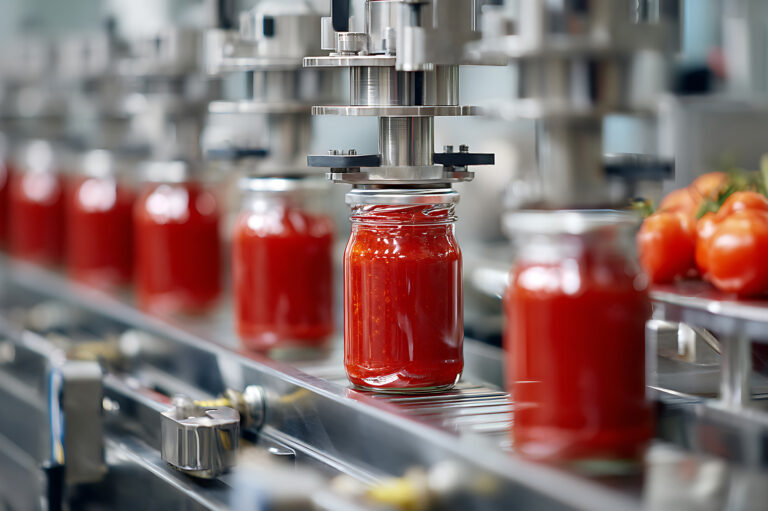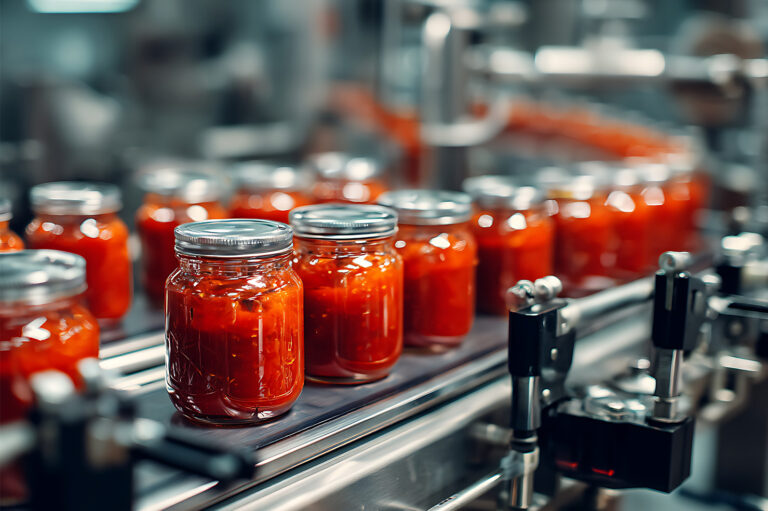UK glass packaging procurement isn’t what it was two years ago. Red Sea rerouting, increasing energy costs and post-Brexit border friction have turned reliable supply chains into operational liabilities. For UK food and drink manufacturers, building resilience is the number one priority right now.
What’s Driving UK Glass Packaging Risk Right Now
Three forces are reshaping the UK glass packaging supply landscape. Each one alone would be significant. Together, they’ve created a perfect storm that’s dismantled the assumptions most procurement strategies were built on.
Maritime Chaos and Border Friction
The Red Sea crisis continues to hit UK supply chains hard. Attacks on commercial shipping have forced carriers to reroute around the Cape of Good Hope, adding three to four weeks to standard delivery times.¹ For UK manufacturers, this is significant: over half (55%) of exporters and 53% of manufacturers report direct impact, with container hire costs jumping up to 300%.²
The effects ripple through production lines. After the crisis began, the UK Manufacturing Output Index dropped to a three-month low, with 80% of firms citing slower deliveries linked to Red Sea disruptions.³ Manufacturers have been burning through inventory buffers just to keep lines running, which leaves them exposed when the next problem hits.
Post-Brexit trade makes things worse. UK-EU trade now means customs declarations, rules of origin documentation, and regulatory checks that weren’t there before. Customs clearance takes one to two days longer on average, and total logistics costs for UK imports grew by 8-15% in the first year after the transition period.⁴ Delivery times from European suppliers have stretched by an average of 30%,⁵ turning what used to be predictable schedules into rough estimates.
Energy Volatility Upstream
Glass furnaces run continuously at over 1,500°C, consuming 9 TWh annually in the UK, with energy making up as much as a third of manufacturing costs.⁶ In recent years, gas and electricity prices have quadrupled and tripled respectively,⁷ creating a situation where production costs can exceed product value.
This energy crisis hits UK glass buyers two ways. First, it threatens the survival of European glass manufacturers who supply the UK market, particularly those in regions with less stable energy pricing. Second, it blocks the industry’s path to decarbonisation as high electricity prices make the capital investments in electrification financially unviable,⁸ which perpetuates fossil fuel dependency and supply uncertainty.
Raw Material Volatility
Right now, £23.6 billion worth of goods sit incomplete in UK warehouses, waiting for key materials.⁹ For glass packaging, the problem runs deep. While the UK has domestic silica sand deposits, soda ash – the second-largest raw material by volume – must be imported and swings wildly in price. The global soda ash market lurches between tight supply shortages and price collapses driven by factors that have nothing to do with UK demand.¹⁰
Even recycled glass (cullet), which cuts both energy use and emissions, faces persistent UK shortages made worse by delays in government resource policies.¹¹ This creates cost pressure and uncertainty for glass manufacturers trying to operate sustainably, which ultimately means longer lead times and less reliability for UK packaging buyers.
For UK food and drink manufacturers, these supply chain pressures show up as immediate operational threats; threats that get worse because of how most businesses currently manage inventory.
Why Just-in-Time No Longer Works in This Environment
The Just-in-Time (JIT) inventory model was revolutionary when it emerged, letting companies cut holding costs by receiving materials precisely when needed. The approach rested on four assumptions: predictable lead times, reliable suppliers, consistent demand, and frictionless logistics.
Every one of those pillars has crumbled. Lead times now swing wildly, stretching by 30% or more because of rerouting and border checks. Supplier reliability has been knocked sideways by energy shocks and raw material shortages. Post-Brexit paperwork has introduced friction that makes precise scheduling nearly impossible. The core logic of JIT—that materials will arrive exactly when you need them—no longer holds.
UK businesses see this. An overwhelming 84% are planning to move away from traditional JIT models.¹² The maths has flipped: the modest savings from minimal inventory get wiped out by the catastrophic costs of a single supply failure.
This shift isn’t theoretical. For food and drink manufacturers, the failure of JIT shows up as concrete, measurable damage on the factory floor.
How This Risk Lands on Your Line
For food and drink manufacturers, glass packaging disruption can be a threat to production itself.
Let’s say, your sauce line runs 20,000 units per day using 370ml jars. A shipment delay of just 48 hours means perishable ingredients spoil, production staff stand idle, and customer orders go unfulfilled. Now you’re losing the revenue from those 40,000 jars, plus paying emergency freight costs, binning raw materials, and potentially facing retailer penalties.
Core packaging lines become single points of failure. Standard formats like the 454g honey jar or the 330ml amber beer bottle are everywhere precisely because they’re production workhorses. If your supplier runs short and you can’t source alternatives quickly, your operation stops.
UK retailers run strict On-Time-In-Full (OTIF) requirements, often with contractual penalties for missed deliveries. Under the Consumer Rights Act 2015, if you’ve agreed a delivery date with a retailer and miss it because of packaging shortages, they can cancel the order and demand a full refund.¹³ Beyond the immediate financial hit, repeated supply failures damage trust, leading to smaller future orders or delisting in favour of more reliable competitors.
Understanding the operational threat is one thing. Putting actual numbers to the financial exposure makes the case for change harder to ignore.
What a Day of Downtime Really Costs
The cost of unplanned downtime usually turns into a cascade of losses that many finance teams underestimate until they experience it.
Across UK manufacturing, machine downtime costs over £180 billion annually, with the average hourly cost at £5,121.¹⁴ For food and beverage producers, the numbers get worse: annual losses of £4–5 billion, with hourly downtime costs ranging from £18,000 to £25,000.¹⁵
Here’s what 24 hours looks like for a mid-sized food manufacturer:
Cost Category | Calculation | 24-Hour Cost |
Direct lost revenue | 20,000 units @ £2.50 each | £50,000 |
Unproductive labour | 2 shifts, 15 staff @ £15/hour | £7,200 |
Wasted perishables | Raw ingredients for one day’s production | £5,000 |
Emergency logistics | Expedited freight for replacement glass | £8,000 |
Subtotal (Direct) | £70,200 | |
Retailer penalty | 5% on £250k weekly order | £12,500 |
Total Impact | £82,700 |
That £82,700 hit from a single day’s stoppage can wipe out months of profit. And this doesn’t count the longer-term damage: lost promotional slots, reduced shelf space, or customers who switch permanently when your product isn’t available.
With the problem and its cost now clear, the question becomes: what’s the practical alternative to a broken JIT model?
The Solution: A Pragmatic Hybrid Approach
The best strategy for modern manufacturers is keeping lean operations where they work whilst building strategic buffers where vulnerability is highest.
The Just-in-Case Buffer
Just-in-Case (JIC) inventory deliberately holds larger stock levels as a safety buffer, putting operational continuity ahead of cost minimisation. Yes, holding costs typically run 20-30% of inventory value annually (covering capital, storage, insurance, and risk).¹⁶ But that needs context.
Compare a 20-30% annual carrying cost against the £82,700 cost of one day’s downtime. If holding £50,000 worth of buffer stock costs £12,500 per year (25% carrying cost), that investment pays for itself by preventing just four hours of production stoppage. The JIC approach becomes insurance with a measurable, positive return.
Building a Targeted Hybrid Model
Most manufacturers don’t need pure JIC across everything they buy. The practical approach is to use both models:
- Segment your inventory using ABC analysis. Sort items by how critical they are and what they’re worth to production.
- Apply JIC principles to ‘A’ items – components that are single points of failure. Primary packaging (jars, bottles) sits squarely in this category. You can’t ship finished product without them.
- Keep leaner JIT operations for less critical ‘B’ and ‘C’ items with stable, predictable supply chains.
The key move is to work with a supplier holding significant UK-based stock of industry-standard containers. Making sure you’ve got a healthy buffer of core lines – your 454g honey jars, 330ml beer bottles, or 500ml sauce jars – can be the single most effective way to prevent production halts during supply shocks.
Why a UK-Stock Partner Changes the Maths
Sourcing from a UK-based supplier with substantial stockholding directly tackles each of the supply risks we’ve outlined.
Lead Time Certainty and Complexity Reduction
Post-Brexit, every EU shipment goes through customs declarations, rules of origin requirements, and regulatory checks. This paperwork adds days to lead times and 8-15% to costs.¹⁷ A UK-based supplier cuts through all of it.
Lead times drop from unpredictable weeks to reliable days. The paperwork disappears. The scheduling certainty needed for efficient operations comes back.
Commercial Agility as Competitive Weapon
Supply resilience also gives you the ability to respond quickly to unexpected demand surges and thus creates offensive competitive advantage.
When a competitor faces a recall, or your product goes viral on social media, the ability to ramp up production within 48 hours captures market share at their direct expense. A manufacturer reliant on international supply chains can only watch while demand passes. A manufacturer with a UK stock partner can fulfil orders immediately, turning a potential crisis into measurable growth.
Measurable Sustainability Impact
International shipping accounts for roughly 2% of global energy-related CO₂ emissions, with UK shipping alone responsible for 22 million tonnes in 2021.¹⁸ Critically, nearly half (46%) of the UK’s carbon footprint comes from emissions embedded in imported goods.¹⁹
Switching glass packaging sourcing from Europe or Asia to a UK supplier dramatically cuts transport miles and associated emissions. For bulky, heavy materials like glass, this delivers measurable Scope 3 reductions which is increasingly important as retailers and investors scrutinise supply chain emissions under net-zero commitments. The procurement decision becomes an ESG decision, tying operational resilience to environmental responsibility.
The 5 Moves That Prevent a Packaging Stock-Out
- Calculate your downtime cost using real production figures and retailer penalties—this is your benchmark for investment decisions.
- Identify your top 10 critical packaging SKUs (the jars and bottles you absolutely can’t run without).
- Hold 4–6 weeks of buffer stock for these core lines, particularly heading into high-volume trading periods (Q4).
- Partner with a UK stockholding supplier to cut border delays and enable rapid replenishment.
- Review quarterly – adjust buffer levels based on demand patterns, new product launches, and supply chain conditions.
Talk to Pattison’s Glass
Pattison’s Glass online outlet Jars & Bottles holds significant UK stock of industry-standard glass jars and bottles specifically to support UK food and drink manufacturers facing these supply challenges. We stock core formats including honey jars, preserving jars, sauce bottles, and beer bottles in depths that enable rapid turnaround for both planned orders and emergency requirements.
Whether you’re looking to de-risk a single core line or develop a comprehensive resilience strategy for seasonal peaks, our team can discuss stocking options, lead times, and buffer planning tailored to your production schedule.
Sources
- British Chambers of Commerce – Scale Of Red Sea Disruption Revealed
- Just Style – Red Sea crisis impacts over half of UK manufacturers, retailers
- The Manufacturer – UK Manufacturing PMI: industry contracts as Red Sea crisis hits supply chains
- Productivity Institute – Unbound: UK Trade post-Brexit
- Zycus – Brexit Impact on Supply Chain in UK
- GOV.UK – Alternative Fuel Switching Technologies for the glass sector
- British Glass – Glass industry responds to the UK energy price crisis
- UK Parliament Hansard – British Glass Industry debate
- Barclays – Supply chain issues see UK manufacturers with goods worth almost £24bn sitting in warehouses
- Chemical Market Analytics – Market Advisory Service – Global Soda Ash
- British Glass – Net zero strategy: Progress Update 2024
- ERP Today – UK businesses to move from ‘just in time’ to ‘just in case’ supply chain model
- Citizens Advice – If something you ordered hasn’t arrived
- FourJaw – The Cost of Downtime in Manufacturing
- Granta Automation – The Hidden Costs of Downtime in Food & Beverage Production
- Netstock – Inventory Holding Costs: How to Calculate and Reduce
- Procuring Group – Post-Brexit Trade: Navigating New Procurement Challenges
- Transport & Environment – A pricey omission: not charging ships for pollution costs the UK £1.6bn/yr
- University of Leeds – Nearly half UK carbon footprint is from overseas emissions


